| |
Norman Allan
: the story
chapter
three: bafflement,
the mind, evolution, complexity (and homeopathy) How
do we know what we know? The philosophers asked this a long time ago. But, more
simple so...
There's
a sense in which we know that water flows.
Where to start chapter
three? I finished chapter two with a reference to spirit as a burning bush in
the mind. A thought about the mind: you know how the gurus (Hindu and Buddhist)
speak of Oneness and of "not two"ness (advaita : nonduality) - so this
thought, this concept is about the analogy between consciousness and water: that
just as there is, on earth, one water that is sometimes in a river, sometimes
a glass of water, sometimes a cactus or a platypus, or a mist, or a tear, so too
there may be one sea/one ocean of consciousness. We are all connected to the Source,
all part of the One, and this is one of the senses in which God is One and All.
Ezra (among many) says, and he might have you say, "I, whomever, am the Light:
I am God: I am Shiva!"
Consciousness
as part of the Source… and so the divine as a "burning bush in the mind."
(I thinks that's so neat, that phrase. Oh, he thinks he's so clever!)
God
as consciousness: sat chit ananda.
"Sat
chit ananda" has been said to be the form of God. Sat is the truth,
the real. Chit is the mind, experience, Ananda is usually translated
as bliss, but, more presicely, ananda is "that which can not be lost
or reduced" (1) - it is the
God-stuff, the quiet abiding. Consciousness as God. (The Buddha mind?)
But
where I want this story to go, I want it to weave through to "ultradiluition".
I wanted to talk about homeopathy, and that discussion will drift back, cross-reference
and weave into the "mind"; you'll see. There's not much I can tell you
about the mind. Oh, some technical neurological stuff… much, surely, as footnotes. Homeopathy.
When I was a young scientist in the 60s I had a vague notion of homeopathy as
pseudoscientific foolishness and placebo: but in the mid 80s it jumped into my
face three times! (2) 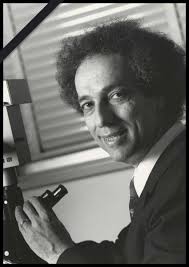 One:
I had gone back to school, studying to be a chiropractor.In the cafeteria line
on day, Dave Talbot said to me, "You're a sulphur. (footnote: the archetypal
sulphur is an absent minded professor.) You'd find homeopathy interesting. It's
a way of dealing with the whole person: a way to work with their mind." One:
I had gone back to school, studying to be a chiropractor.In the cafeteria line
on day, Dave Talbot said to me, "You're a sulphur. (footnote: the archetypal
sulphur is an absent minded professor.) You'd find homeopathy interesting. It's
a way of dealing with the whole person: a way to work with their mind."
Two:
While I was studying, I was also working part-time in Prof, Bruce Pomeranz lab.
Bruce was a most important researcher of alternative medicines. In the mid-seventies
he had shown that acupuncture analgesia was mediated through endorphins. (4)
This is probably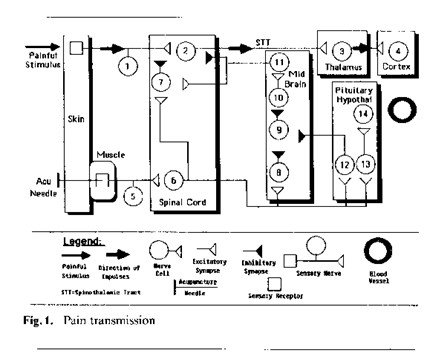 the first, and possibly the most dramatic, demonstration of a "scientific"
causal mechanism for an Alternative Medicine as he traced the pathways through
the spine and brain..
the first, and possibly the most dramatic, demonstration of a "scientific"
causal mechanism for an Alternative Medicine as he traced the pathways through
the spine and brain..
In
the mid-eighties Prof. Pomeranz was invited to a little think-tank session in
the Bahamas. (5) Here he met Jacque
Beneveniste.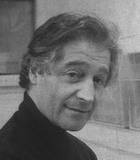 Beneveniste (6) was doing an experiment
with "ultradilute" antigens. Homeopathically dilute IgE could stimulate
human basophils (7) to release their
histamine! Beneveniste enlisted Pomeranz to be one of three labs that would replicate
his work.
Beneveniste (6) was doing an experiment
with "ultradilute" antigens. Homeopathically dilute IgE could stimulate
human basophils (7) to release their
histamine! Beneveniste enlisted Pomeranz to be one of three labs that would replicate
his work.
Three: so with this as the immediate background, let me introduce
the grey cat. Grey, our fourteen year old tabby, had started peeing out of place,
urinating on cushions - on sofas and chairs. "It's senile dementia,"
said my daughter. "She's a spiteful old cat," said my wife. (8)
And she was very nearly an ex-cat. But, being then involved in studying alternative
medicine (clinically training as a chiropractor and involved with research at
the University of Toronto), I decided to "repertories" incontinence
in a homeopathic manner. (9) One
of the many remedies for incontinence is Gelsinium, "yellow jasmine".
Gelsinium has as a peculiar "proving" the following "rubric":
"infant fears to fall and clings to nurse or crib". For six months Grey,
when I picked her up, would hug her body close up to me and grip tight - so on
the basis of this rubric, "clings to nurse", I splashed some homeopathic
Gelsinium (10) into Grey's face
- she licked drops off her nose - and she stopped clinging, and she stopped urinating
out of place. I wished that I had been more of a scientist and had splashed water
in her face first as a "control" (but perhaps that wouldn't have been
ethical).
Now an interesting
thing about homeopathy and the mind is that when a homeopath is "taking a
case" we give a weight and emphasis to so called "mentals" (over
and above physical symptoms): mental symptoms like "infant fears to fall."
And that, I think, will lead
us into chapter three…
Chapter
three: re. the search for the mind: a rambling beginning … laced through
with ultradilution. Last
winter (11) Enzo wanted to hold
evening talks/forums at his new age shop, Alternative Thinking. "Why don't
you talk, or lead a forum, on the search for the mind?" he suggested. So
I did.
Mind mind mind. What
is the mind? "The search for the mind" might mean several things…
well, two things spring to mind. The intellectual, scientific "search"
to understand what the mind is and how the mind works. And/or the spiritual quest
to experience the "mind", the self, to experience experience directly.
There is that wonderful expression:
"The map is not the terrain." And words are like a map. They point to
things, to experiences; and our mental chatter, our verbal concepts, come between
us and our direct experience. If we can be without words, it is quite transcendent.
There is a knowing, some more direct knowing, without words.
My
vipassana teacher (12) said
once of the three major schools of Buddhism, that each teaches a way to "stop"
the (verbal) mind: Zen through the pondering imponderables; Tibetan Buddhism through
filling up the mind with ritual and repititions; and Thiavadan through "fix
pointedness", e.g. concentration on the breath.
The
Buddhists say: the nature of the mind is clarity, and function of the mind is
knowing. They say the mind is that which perceives and feels, discerns desires,
intends and wills.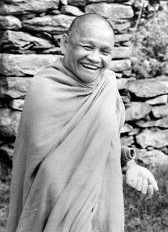 It is that which knows, but it can never know itself. My teacher's (13)
teacher, Ajahn Chah,is very emphatic about that. Simply put: the mind cannot be
known. (14) While we cannot
"know", as in "understanding" the mind, but only experience
the mind directly, we can, though, know somethings about the mind: for
instance: thank Freud we know of the unconscious, that there is one. And we can
observe, for instance, that the mind exists over/in an extended smear of time,
as it were. It's not a sharp instant. If you speak, or hear spoken, the eternal
now, "The Eternal Now," that phrase has a duration (about a second
when spoken), and some part of your mind hears the whole phrase. (multiple parts
to experience ! ? )
It is that which knows, but it can never know itself. My teacher's (13)
teacher, Ajahn Chah,is very emphatic about that. Simply put: the mind cannot be
known. (14) While we cannot
"know", as in "understanding" the mind, but only experience
the mind directly, we can, though, know somethings about the mind: for
instance: thank Freud we know of the unconscious, that there is one. And we can
observe, for instance, that the mind exists over/in an extended smear of time,
as it were. It's not a sharp instant. If you speak, or hear spoken, the eternal
now, "The Eternal Now," that phrase has a duration (about a second
when spoken), and some part of your mind hears the whole phrase. (multiple parts
to experience ! ? ) What
do we know about the mind from the perspective of neuroscience? Not a lot. But
see the footnote. (15) Oh,
"mirror neurons" are interesting. "Mirror neurons" is actually
a misnomer arising from their serendipitous discovery.(16A)
They are actually neurons associated with a specific (often goal directed) activity
(16B) - so perhaps "action"
neurons, or "intention" neurons, even "idea" neurons ! (16C)
(A clarification: these neurons are firing in association with an action, intention,
idea. They are not the action, intention, idea itself. They are part of a neural
pattern, a gestalt associated with that action/intention/idea. ) Mind?
When did I first start my personal quest (this is Norman Allan's story), my personal
quest to understand the "mind"? That tracts back. When I was eleven
my family left Toronto for England. Ted, my dad, was chased out of the States
back up to Canada in 1949 when I was six. A bit before McCarthy, but well into
the red-hunts and black listings. When in the fifties he had a play in rehearsal
for the CBC TV drama hour: a play which questioned the values of mass production
and commercialism - the set had been built, rehearsals had started, when the show's
"sponsor", one of the big three automakers, decided they would not sponsor
a play with this moral; they did not like the meme. The play was cancelled, scrapped,
and Ted decided it was time to leave Toronto.
We
moved to London.
Next year,
when I was twelve, I was put into therapy, counseling, psychoanalysis. Why? My
father said because (in part) I had begun to stutter. But I think it was because
he was getting ready to leave my mum, Kate, and he was looking to provide me with
surrogate parenting. And also, Ted too was interested in therapy (for himself),
was shopping around in this way. He ended up in therapy with my analyst's analyst,
Claire Russell, and worked with her off and on for thirty years.
My
analyst, Caroline Nicholson, had a profound influence on me. You might say that
as other's are raised Catholics (or Baptists or Muslims), I was raised as a Freudian.
Meaning? At one simple level, it was my teenage ambition to study and understand
the mind. (Yeah, yeah, but what did Freud teach you? That repression, and that
the unconscious, are huge!)
Claire
Russell's husband was an ethologist. A what? The famous one, the famous ethologist
is Jane Goodall. Ethology is a branch of Zoology. It is the study animal behavour
in its natural context. As opposed to this there is "behaviourism" which
is a study of how animal behave in the laboratory - in boxes and mazes - and this
"experimental animal psychology" totally dominated University psychology
departments(*). So my mentors said,
"If you want to study 'mind' at university you must study zoology, rather
than psychology."
My
Ph.D. research. however, ended up as a (primarily) neurophysiological study. (**)
It was a study of the neural motor programming of vocalization in the chick. (***)
Sometimes I confess that I used to take baby chicks apart to see what made them
peep. Actually, it turns out to be the interaction of three (quasi-sinusoidal
oscillators) waveforms. (17)
In the year following my graduate work, I did a years post-doc at Toronto's York
University in the psychology department. And that brings me back to skinner boxes!
Sharing the room next to me was an M.Sc. student, Bill Crow. Bill was studying
for his Master's and working at the same time (for a small wage) conducting an
experiment for one of the experimental psychology profs. And yes, it was skinner
boxes! White laboratory rats given a problem to solve and press one of two levers
that would open a sliding door in the wall where the rat would find a "reward",
a food pellet. Then the door would close and a "hopper" would deliver
a new pellet to the reward hatch/chamber. Bill maintained the equipment and the
rats and ran the experiment. And collected the data. One of the rats, Bill noticed,
was producing/generating strange data. Very strange. Bill started calling that
rat Bizarro, and he decided he would take a look to find out what was going on.
So Bill watched Bizarro solve a problem, that is, push the correct lever. The
hatch door opened on an empty food/reward chamber! then closed. After the door
closed the food hopper delivered another food pellet. Bizarro went over to the
reward hatch, lay down on his back. With one paw he opened the sliding hatch door.
With the other paw he reached in and took out the reward pellet. He ate it. Then
he went back to solve the next discrimination puzzle. The door would open on an
empty reward chamber, and close, and another pellet would be delivered. Bizarro
was out of sync.
Bill went
to the professor to tell him of this strange behaviour. He was chastised. "You
mustn't observe the subjects in the skinner box! It contaminates the experiment
with all sorts of potential observer phenomena!"
"Observer
phenomena!" An observer may affect the outcome of an experiment in known
and unknown ways. We will come back to "observer phenomenon" later talking
about the quantum universe, and sooner, in this chapter, talking a little more
about Pomeranz and Beneviniste and homeopathy. But first I must tell you a story
about Bill Crow's grandmother. Grandmother
Crow
In 1970 Bill Crow was a graduate student. He shared an office
next door to mine. Bill Crow was one quarter native: his grandmother was full
blooded Cheyenne. After the Indian Wars the army had herded the Cheyenne into
two camps. Bill's grandmother was eleven years old in the 1880s when the army
marched the eleven hundred remnants in the southern camp a thousand miles, in
the middle of winter, to the northern camp. Only one hundred of those eleven hundred
souls survived the march, and these included Bill's grandmother.
Bill
was a student during the Vietnam war - he studied psychology at Berkeley - and
he was a member of the radical SDS (Students for a Democratic Society). When he
graduated he got his draft notice. He decided to come north to Canada to do postgraduate
work and to avoid participating in what he saw as an unjust war.
Before
going north, though, Bill went home to Mobile to see his family. His Granny was
then in her eighties and he wasn't sure whether he would see her again. He went
in to Granny to tell her he was going to Canada to dodge the draft. Granny nodded
her head sagely and said, "You'll come back for the war, though, won't you?"
In 1986 (round the time
I graduated as a chiropractor) we (Pomeranz lab) were working on the Beneviniste
unltradilution experiment. In this experiment (18)
you take an antigen that will trigger "basophils" to release their histamine
(we say that they "degranulate"): you count the number of basophils
and then challenge them with the antigens and see how many have degranulated.
Then you dilute the antigen one part in ten, and repeat, then dilute it again
and again. At some point, some dilution, it stops triggering degranulation. But
if you go on futher diluting the antigen, at certain points the activity, the
degranulation, returns!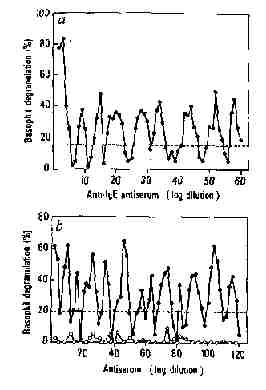 And we saw this homeopathic effect in our lab, except we only saw it 20 or 25
percent of the time. Which was troubling. So Elizabeth Davenas, who was the scientist
in Benveniste's lab who was actually
And we saw this homeopathic effect in our lab, except we only saw it 20 or 25
percent of the time. Which was troubling. So Elizabeth Davenas, who was the scientist
in Benveniste's lab who was actually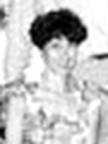 doing the bench work, Elizabeth (19)
came over from Paris to work with us at the U of T to see if she could improve
the "robustness", the repeatability of the phenomenon in our lab. And
she did. She spent two weeks with us and by the second week we could do the experiment
reliably. It worked every time. And the effect, the improvement, didn't disappear
(immediately) when she left. But it did degrade, gradually, to a point where we
were back where we started three weeks later (seeing the phenomenon 20 to 25%
of the time).
doing the bench work, Elizabeth (19)
came over from Paris to work with us at the U of T to see if she could improve
the "robustness", the repeatability of the phenomenon in our lab. And
she did. She spent two weeks with us and by the second week we could do the experiment
reliably. It worked every time. And the effect, the improvement, didn't disappear
(immediately) when she left. But it did degrade, gradually, to a point where we
were back where we started three weeks later (seeing the phenomenon 20 to 25%
of the time).
I used to think
that my main function in Pomeranz lab was not the bench work I did (20),
but was taking lunch with Bruce once a weak in the cafeteria, acting as a sounding
board for him to verbalise his thoughts, his ruminations. When it came time for
us to confirm to the journal, Nature, that we'd replicated Beneveniste's work,
Pomeranz was troubled. Why had the protocol been reliable while Davenas was with
us but degraded again when she left? Was that because it's a delicate procedure
that needs to be done "just so"? One would think this is a likely reason.
But Bruce worried that is might be an "observer effect". That the (reliability
of the) ultradilute degranulation was somehow something Davenas was doing with
her mind, with her intent. So, in the Davenas
Beneviniste Nature paper (21) Pomeranz reports that we had "interesting
preliminary results."
Now there's
a lesson that I should have learned from Bruce. About credibility. For a scientist,
particularly someone studying controversial phenomena, credibility is essential,
a basic, a sine qui non. At some point in his career Bruce and a colleague
became interested in "spoon-bending". They did some preliminary research,
but not at the lab at the U of T. Rather they worked hidden away in Bruce's basement!
So why then, if I want to tell you important
things about science and homeopathy, am I talking about ESP and spirit? Because
this is a story about me and about my world. A lot of my world revolves round
intellectual stuff. Ahh there there! And bits of the world are quite strange.
My life, probably like yours, I have conceived of it, in grandiose moments, as
a search for the truth. (22)
But, Ajahn Chah, who said you can not know
the mind (perhaps contrarywise the Buddhist project is for the mind to know you!),
Ajahn Chah also asks about (just about) everything, "Is that sure?"
What can we know, and what we can't know.
Mind verses matter. Water flows.
Before we move on to the next chapter,
which is going to be about "evil", I have something (sure) to tell you
about the mind and the world; about creative intelligence and evolution; about
"complexity" and about "emergent phenomena". Complexity:
if a mathematician, physicist, engineer considered the gravitational and spacial
interaction of two moving bodies in space, they can predict how they will interact.
But, the interaction of three bodies in space cannot be computed! This is called
"the three body problem". (23)
Furthermore: in mathematical models of the
world things may add and subtract and multiply in a "linear" fashion.
However, in most (or many) systems in the real world, things interact and these
interaction are not (precisely) predicable: they are "nonlinear". Nonlinear
equations are not solvable! (24)
When things interact they get complicated
very quickly. Even in linear systems. A wonderful example of this is the Mandelbrot
set (and the Julia sets from which it derives. The Julia sets describe the interative
expression z ~> z2 + c (25).
When we map out the Julia set for c=-0.835-0.2321i as a graphic representation
it look like this: The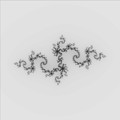 Mandelbrot set (which describes aspects of the behaviour of the Julia sets)is
a relatively simple iterative system which appears, however, to be very complex.
It is very beautiful, and it can be (almost?) infinite in its complexity.
Mandelbrot set (which describes aspects of the behaviour of the Julia sets)is
a relatively simple iterative system which appears, however, to be very complex.
It is very beautiful, and it can be (almost?) infinite in its complexity.
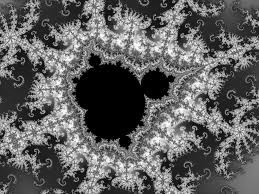
But
the thing I want to come to (in this consideration of complexity) is that even
in the simplest systems things occur, things emerge, which cannot be predicted.
"Emergent phenomena".
The best example I know, of emergent phenomena, (26)
is "Langton's ant". (27)
This concerns behaviour in a grid of black or white squares. We will call one
square "it", one square has the "ant". The ant moves to another
square. If that (new) square is white, it will turn to black: if black it will
turn white. If that square was white the "ant" will move to the next
square to the right. If the new square is black the "ant" turns left.

During
the first few hundred moves the behaviour of Langton's ant appears to be relatively
simple. During the next few thousand moves the behaviour appears to be chaotic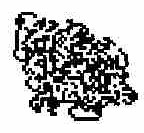 .
But sometime after the ten thousandth move a curious repetitive pattern emerges .
But sometime after the ten thousandth move a curious repetitive pattern emerges ,
and is stable: a repetitive pattern with a hundred and three moves per cycle,
and it is nothing we could possibly predict from the simple rules of this game/puzzle/problem. ,
and is stable: a repetitive pattern with a hundred and three moves per cycle,
and it is nothing we could possibly predict from the simple rules of this game/puzzle/problem.
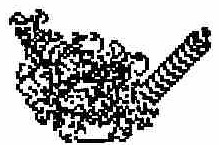
Now,
how does this relates to what I've been discussing… It relates to "creative
intelligence", and perhaps to the mind.
Consider
"creative intelligence" (spirit). I know of it because it said "Hello!"
it waved in my face! I know of it empirically, though unfortunately only "anecdotally".
Then given that there is a creative intelligence (and that does as it pleases),
does this mean that creative intelligence is involved in evolution? Not at all
necessarily! That needs to be decided empirically, and (so far) ya can nay do
that! Yes, there many aspects of evolution that we still don't fully comprehend,
but that's hardly surprising. And while there is no saying that spirit doesn't
intervene (in evolution), there is no evidence that she does.
What
Ken Wilbur has to say about "evolution" is interesting.
Evolution:
Things differ in their complexity. There are different levels of organisation
in phenomena and these amount to different orders, realms or dimensions of being.
So there is the insentient realm of matter and energy and from this, though the
phenomenon of "emergence", living systems have evolved. In his book
"Eye for Eye", Wilber points out that there is a hierarchy of organisation
in the universe and that the relationships in this hierarchy are asymmetrical.
The things and properties that pertain to the physical domain subsume the domain
of living organisms, but those things that characterise living creatures are not
necessarily properties of their material substrate. Rocks don't walk. And then,
from living organisms the "mental" sphere and the "rational"
seem to emerge, and from the mental the "subtle" emerges, from the subtle
the "causal", from the causal the "Absolute". (Me, personally,
I don't quite know what Wilber means by "subtle" and "causal")
Wilber writes, "Four levels of
being are the absolute minimum you can use to explain the world's great mystical
religions. Those are physical-body, symbol-mind, subtle-soul, and causal-spirit."
Some philosophers describe seven levels as, for instance, those symbolised by
the chakras. Others have reduced existence to the three broad categories of body,
mind and spirit. "Each higher level cannot be fully explained in terms of
a lower level. Each higher level has capacities and characteristic not found in
lower levels. This fact appears in evolution as the phenomena of creative emergence."
Failing to recognise that the higher cannot be explained simply by the lower has
led reductionist science into serious "category errors" (28).
Biology cannot be explained only in
terms of physics. Psychology cannot be explained only in terms of biology. Each
"higher" stage includes the lower as components but also transcends
them by adding its own defining attributes. All the lower is in the higher, but
not all the higher is in the lower. A three-dimensional cube contains two-dimensional
squares, but not vice versa. And it is that "not vise versa" that creates
hierarchy. Plants include minerals but not vice versa; the human neocortex has
reptilian features, but not vise versa. Each stage of evolution transcends, but
includes, its predecessor.
Involution:
Wilbur says as well as an evolution of matter into mind into spirit, there is
a reciprocal involution of spirit to mind to matter. But let's leave the matter
here. (29)
Reading
my writing on Wilbur my friend, Bill, said, "I'm a fairly simple, down to
earth guy and I find reading this "stuff" almost painful in it's abstractions
and intellectualized verbosity. That's one thing I like about the Natives: they
use few words, grunt and haw occasionally, suffer well and "see" and
"feel" the trees and the birds easily." I
have a more to say about mind and matter, but maybe we can leave that for a later.
So let's just finish chapter three with a poem…
Consider
the Lilies
she
said we come from the light
but I say we are molded from mud
and that explains
all our stupidities
we're
pretty smart for beasts
but locusts perish
in rat city it's dog eat dog
and
whether we wake or not
matters only a jot
cause it's all already accomplished God
is evolved
mud into mind
mind into spirit
worlds without end we
are vouched safe in a flower
chapter
4 : evil and click
here: for contents and chapter one
|